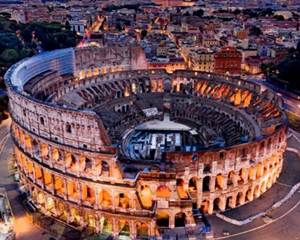The letters turned out to be part of the Greek word for "purple," making Farritor the first person to glimpse a word of this scroll since it was buried under dozens of feet of volcanic debris.
這些字母原來是希臘語“紫色”一詞的部分字母,法里托成為自這個(gè)卷軸被埋在數(shù)十英尺火山灰下后第一個(gè)見到這個(gè)卷軸上單詞的人。
The scroll was one of about a thousand recovered in the 1700s after well diggers found the villa, which lies beneath the modern town of Ercolano.
這個(gè)卷軸是18世紀(jì)回收的大約1000個(gè)卷軸中的一個(gè),當(dāng)時(shí)挖井工人發(fā)現(xiàn)了這座位于現(xiàn)代小鎮(zhèn)埃爾科拉諾下的別墅。
Scholars say this trove was likely the Greek library of the Epicurean philosopher and poet Philodemus.
學(xué)者們說,這批藏品很可能來自伊壁鳩魯學(xué)派哲學(xué)家和詩(shī)人菲洛德默斯的希臘語圖書館。
But they suspect a larger Latin library may be in a section of the villa that has yet to be excavated.
但他們懷疑,在尚未挖掘的別墅里,可能有一個(gè)更大規(guī)模的拉丁語圖書館。
If the competition demonstrates that scholars can read unopened scrolls safely and easily, it could galvanize the search for more historic material.
如果比賽表明,學(xué)者們可以安全、輕松地閱讀未開封的卷軸,這可能會(huì)激發(fā)人們對(duì)更多歷史材料的尋找。
Such a collection might contain lost masterworks of Greek and Roman history, philosophy, and literature.
這些藏品可能包含了希臘和羅馬歷史、哲學(xué)和文學(xué)中遺失的名著。
If no more scrolls are discovered, "this will still change our understanding of the ancient world," says Garrett Ryan, a historian and podcaster who studies ancient Greece and Rome.
研究古希臘和羅馬的歷史學(xué)家加勒特·瑞安說,即使沒有更多的卷軸被發(fā)現(xiàn),“這仍將改變我們對(duì)古代世界的理解”。
But if the library is located, it will be "a profound revolution in the classics."
但如果人們找到圖書館所在,它就將是“古典學(xué)領(lǐng)域的一場(chǎng)深刻革命”。
Brent Seales, professor of computer science at the University of Kentucky, co-founded the Vesuvius Challenge with tech investors Nat Friedman and Daniel Gross.
肯塔基大學(xué)計(jì)算機(jī)學(xué)教授布倫特·西爾斯與科技投資者納特·弗里德曼、丹尼爾·格羅斯共同創(chuàng)立了這次維蘇威挑戰(zhàn)賽。
Seales and his lab did seminal work on ink detection and digital unwrapping that competitors are building upon.
西爾斯和他的實(shí)驗(yàn)室在墨跡識(shí)別和數(shù)字解包方面做了開創(chuàng)性工作,參賽者正是在此基礎(chǔ)上繼續(xù)的。
By launching the contest, they seem to have added more urgency, collective brainpower for this sort of noninvasive historical investigation.
通過發(fā)起這場(chǎng)比賽,他們似乎為這種非侵入性歷史調(diào)查增加了更多的緊迫感、集體智慧。

Farritor's "purple" breakthrough was just the beginning.
法里托在“紫色”一詞上的突破只是開始。
To make the most progress possible, Farritor and two other competitors teamed up.
為取得盡可能多的進(jìn)展,法里托和其他兩名參賽者組了隊(duì)。
They went on to win the grand prize of $700,000 earlier this year for revealing 15 columns of text from the scroll, more than 2,000 characters.
后來,他們?cè)诮衲暝缧r(shí)候贏得70萬美元的大獎(jiǎng),因?yàn)樗麄儚木磔S中讀出15列文本,超過2000個(gè)字符。
Their submission far exceeded the challenge's original goal of reading four passages of 140 characters each.
他們提交的成果遠(yuǎn)遠(yuǎn)超過挑戰(zhàn)賽最初的目標(biāo),即讀出四段文本,每段140個(gè)字符。
All three were using AI a little differently.
三個(gè)人使用人工智能的方法略有不同。
Like Farritor, team leader Youssef Nader, 28, an Egyptian working on his Ph.D. in AI and machine learning in Berlin, focused on improving ink detection.
和法里托一樣,28歲的團(tuán)隊(duì)負(fù)責(zé)人優(yōu)素福·納德爾--在柏林攻讀人工智能和機(jī)器學(xué)習(xí)博士學(xué)位的埃及人--專注于提高墨跡識(shí)別水平。
Rather than start with a manual inspection of crackle patterns, Nader trained his model on ink found on fragments of damaged scrolls.
納德爾沒有從人工識(shí)別裂紋紋理開始,而是用從損壞卷軸的碎片上找到的墨跡來訓(xùn)練他的模型。
He applied the model to sections of a CT scan showing the target scroll's internal structure that the contest organizers had made by placing the scroll in the beam of a particle accelerator.
他將該模型應(yīng)用于CT掃描的部分,該掃描顯示了比賽組織者通過將卷軸放置在粒子加速器的光束中而制作的目標(biāo)卷軸的內(nèi)部結(jié)構(gòu)。
Nader's process enabled crisper, more precise renderings of the characters.
納德爾的工作使得字符的渲染更加清晰、精確。



